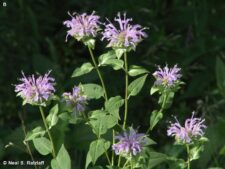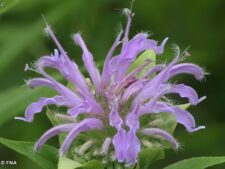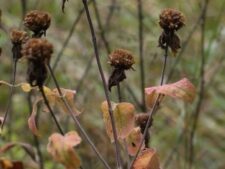
This native perennial often occurs in colonies (A) formed by spreading underground stems (rhizomes). Square, erect, variably branched above-ground stems are up to 5 feet tall. Opposite, usually stalked leaves with toothed margins are up to 4 inches long and 2 inches wide (B). Circular 1 1/2 inch flower heads with many tube-shaped, two-lipped, pink to reddish-violet to lavender flowers occur at the tips of the branches (C). Two stamens and a single style protrude beyond the narrow upper lip. The wider lower lip curves downward and has a 3-lobed tip (C). Erect, dry stems and seed heads, with their minty aroma, may persist through the winter (E,F).
Grows in moist prairies and along woodland edges, flowering from June through August. In Fontenelle Forest, Wild Bergamot is common along Prairie Trail in the planted upland prairie and abundant in the recently planted Floodplain Prairie along Hidden Lake Trail east of the observation blind. At Neale Woods, it is common in Knull, Nebraska and Jonas Prairies.
Bergamot tea was widely used by Native Americans as a medicinal agent and is still used today in herbal tea preparations. Leaves, which resemble oregano in taste and aroma, were used as a seasoning for food by the early settlers. The bergamot in Earl Grey tea is an extract from the rind of a citrus fruit, the bergamot orange, an unrelated plant native to southeast Asia.
Other common names include Oswego Tea, Horsemint and Bee Balm.
The content of NatureSearch is provided by dedicated volunteer Naturalists of Fontenelle Forest who strive to provide the most accurate information available. Contributors of the images retain their copyrights. The point of contact for this page is: Neal Ratzlaff.





